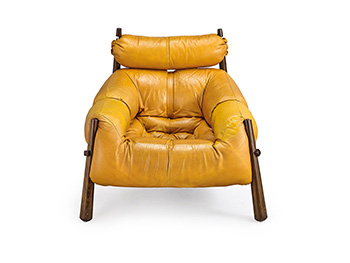Catalogue Note:
A LASTING LEGACY OF INGENUITY
After WWII, many industries remained to be done, and people looked forward to the future, to a better life. It is a time where different ideas flourished, artists, poets, writers, and designers were free from traditional restrictions. Limitations upon art and creative expression were lifted, and coupled with developing information and new knowledge, art and literature took off, full of kaleidoscopic wonders, most notable of which is Abstract Expressionism, Neo-Dadaism, and Pop Art from New York. This sudden liberation of ideas was not limited to artistic expression.
In plastic arts such as craft design, French Modernism, otherwise known as Art Deco, was a trend that started in Paris that became a sensation. Art Deco and the German Bauhaus style were hailed as the most modern and avant-garde design styles at the time. Then came the 30s, when many places around the world sand into a period of depression. These two aesthetic styles were suppressed, and was silent. At the same time, a brand new style began to develop. A modern design style that integrated family functions into traditional craft emerged from Scandinavia, and began its widespread influence. This Scandinavian trend reached its peak in the post-war 1950s. Under strong design principals, the exquisite craftsmanship, simplistically structured appearance, and bold and unique aesthetic concepts of this style swept across Europe, making Scandinavia a design capital in its own right.
The Scandinavian aesthetics were led by three countries, but diverged and shined in different ways due to geological and political differences. The concepts of these highly influential artists not only impacted contemporary design ideas, but also deeply influenced innovation in plastic arts for later generations, even being hailed as the ultimate standard. Among the most famous of these artists, are Danish designer Hans Wegner, and Finland's aesthetic master of design, Svend Aage Madsen. As they strive towards perfection, breakthroughs, innovation, and functionality, they also held on to their original intention, which is to care for people, and that's what made these chairs and furnitures grand, classic creations. Other than this Scandinavian trend, a sophisticated, elegant design aesthetics stemming from the German Bauhaus style emerged in Europe, while Brazil also caught up with this new wave of creative ideas, with famous designers like Percival Lafer, who not only creates works steeped in architectural philosophy, but also insists on crafting elegant, accessible pieces that does not pander to elitism. His ideals and intricate rosewood designs put him among the top designers of the world. To this day, every one of these pieces are not only functional, but also the prize of many galleries and museums around the world. The craft aesthetics these artists possess made their works transcend their original creative concept, into intricately crafted and aesthetically pleasing sculptures with exquisite material, that are very much significant to this era.
After WWII, many industries remained to be done, and people looked forward to the future, to a better life. It is a time where different ideas flourished, artists, poets, writers, and designers were free from traditional restrictions. Limitations upon art and creative expression were lifted, and coupled with developing information and new knowledge, art and literature took off, full of kaleidoscopic wonders, most notable of which is Abstract Expressionism, Neo-Dadaism, and Pop Art from New York. This sudden liberation of ideas was not limited to artistic expression.
In plastic arts such as craft design, French Modernism, otherwise known as Art Deco, was a trend that started in Paris that became a sensation. Art Deco and the German Bauhaus style were hailed as the most modern and avant-garde design styles at the time. Then came the 30s, when many places around the world sand into a period of depression. These two aesthetic styles were suppressed, and was silent. At the same time, a brand new style began to develop. A modern design style that integrated family functions into traditional craft emerged from Scandinavia, and began its widespread influence. This Scandinavian trend reached its peak in the post-war 1950s. Under strong design principals, the exquisite craftsmanship, simplistically structured appearance, and bold and unique aesthetic concepts of this style swept across Europe, making Scandinavia a design capital in its own right.
The Scandinavian aesthetics were led by three countries, but diverged and shined in different ways due to geological and political differences. The concepts of these highly influential artists not only impacted contemporary design ideas, but also deeply influenced innovation in plastic arts for later generations, even being hailed as the ultimate standard. Among the most famous of these artists, are Danish designer Hans Wegner, and Finland's aesthetic master of design, Svend Aage Madsen. As they strive towards perfection, breakthroughs, innovation, and functionality, they also held on to their original intention, which is to care for people, and that's what made these chairs and furnitures grand, classic creations. Other than this Scandinavian trend, a sophisticated, elegant design aesthetics stemming from the German Bauhaus style emerged in Europe, while Brazil also caught up with this new wave of creative ideas, with famous designers like Percival Lafer, who not only creates works steeped in architectural philosophy, but also insists on crafting elegant, accessible pieces that does not pander to elitism. His ideals and intricate rosewood designs put him among the top designers of the world. To this day, every one of these pieces are not only functional, but also the prize of many galleries and museums around the world. The craft aesthetics these artists possess made their works transcend their original creative concept, into intricately crafted and aesthetically pleasing sculptures with exquisite material, that are very much significant to this era.
